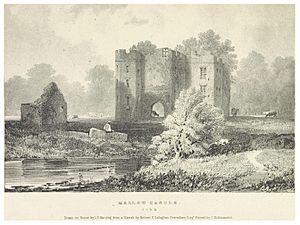Thomas Norris (died 1599) facts for kids
Sir Thomas Norris (1556–1599) was an English soldier who lived a long time ago. He was a member of the Irish House of Commons, which was like their parliament. He also became the Lord President of Munster in Ireland, a very important leader. Sometimes, his last name is spelled Norreys.
Contents
Who Was Sir Thomas Norris?
Sir Thomas Norris was the fifth of six sons. His parents were Henry Norris, 1st Baron Norreys and Margery Williams. His family lived in places like Rycote House and Wytham Abbey in Oxfordshire, England.
When he was 15, in 1571, he started studying at Magdalen College, Oxford. He earned his first degree in 1576. His brothers, Sir John Norris and Sir Edward Norris, were also well-known.
Sir Thomas married Bridget Kingsmill. They had one daughter, Elizabeth, who was his only child and inherited his property. Elizabeth later married Sir John Jephson. Sir Thomas Norris built Mallow Castle in Ireland. This castle stayed in his daughter's family for a very long time, until the 1980s.
Sir Thomas Norris's Military Career
Sir Thomas Norris was a brave soldier who spent much of his life in Ireland.
Early Military Roles
In 1579, he became a captain in the army in Ireland. He took over after his oldest brother, William, passed away. He fought against Gerald FitzGerald, 15th Earl of Desmond, a powerful Irish leader.
Later, in 1580–81, he acted as the governor of Connaught province. He worked to bring peace to the area and dealt with groups causing trouble.
In 1581–82, he became the colonel of the forces in Munster. He stopped the Earl of Desmond from attacking Dingle. However, he didn't have enough soldiers or supplies to do more.
Important Missions and Appointments
In 1583, he visited England briefly. When he returned, he helped settle a disagreement in Ulster over a castle called Shane's Castle. He was praised for his good work by important leaders.
In 1584, he joined an expedition against Scottish groups in Antrim. During this time, he was wounded in the knee by an arrow while searching for Sorley Boy MacDonnell.
He returned to Munster and, in 1585–86, he represented County Limerick in the Irish Parliament. In December 1585, he became the vice-president of Munster. This was a challenging job because the situation was not stable.
Dealing with Challenges
In 1587, Norris arrested some local leaders whose loyalty was questioned. He also faced a tricky situation involving the marriage of Ellen, the daughter of Donald McCarthy, 1st Earl of Clancare. Her marriage was very important politically, and Norris himself decided not to marry her.
In 1588, Ellen married Florence MacCarthy, which caused more political tension. Norris arrested Florence, but later believed he was innocent. In December, Norris was made a knight. He also received a large area of land around Mallow.
After the Spanish Armada was defeated, there were still fears of invasion. So, in 1589–90, Norris worked with an engineer to make the forts in Limerick, Waterford, and Duncannon stronger. Money was tight, and some soldiers in Limerick even protested because they weren't paid.
In 1592–93, Norris went to England to report on the new settlements in Munster. He returned to Ireland in May 1593. The area was mostly peaceful, except for some small disturbances.
Later Campaigns and Leadership
In 1594, Norris met the new lord-deputy, Sir William Russell, in Dublin. He then traveled with him through Ulster. The next year, he fought alongside his brother, Sir John Norris, against the Earl of Tyrone. He was wounded in the thigh during a battle in September.
He helped his brother bring peace to Connacht in 1596. But in August, he had to fight off groups attacking Munster. He was very tough, hanging many of them, but they kept fighting back. He went back to Connaught with his brother in September.
When the governor of Connaught was removed, Norris was temporarily made president of the province. After a new president arrived, Norris returned to Munster and brought peace to the area by June 1597. When his brother, Sir John Norris, died that year, Sir Thomas became the Lord President of Munster on September 20. He was also chosen to be a lord justice of Ireland, a very high position. However, Queen Elizabeth I did not confirm this, saying he was needed more in Munster. So, he returned to Munster in November.
Later Years and Death
In August 1598, after a major battle called the Battle of the Yellow Ford, many Irish people rebelled. Groups from Leinster attacked Munster. Norris gathered his soldiers near Mallow, but he didn't feel strong enough to fight them directly, so he moved his forces to Cork. Some people criticized him for this retreat.
By December, he managed to help the town of Kilmallock, even though he was heavily attacked. In March 1599, he tried another expedition, but only captured Carriglea Castle. He returned to Cork in April, fighting the Irish along the way.
The arrival of Robert Devereux, 2nd Earl of Essex, a powerful English leader, gave him a short break. Norris met him and then returned to Munster. On May 30, while traveling, he was attacked by Irish troops and was wounded in the neck by a spear. His attackers were defeated, and Norris reached Limerick. He then helped resupply another fort and joined Essex, traveling with him through the province.
However, his wound got worse. He was taken to Mallow Castle and suffered for some time. Sir Thomas Norris died there on August 20, 1599.
Literary Connection
Sir Thomas Norris was friends with Lodowick Bryskett, who was also a friend of the famous poet Edmund Spenser. Bryskett mentioned Norris as one of the people present when Spenser talked about his plan to write his famous poem, The Faerie Queene, in the late 1580s.
Images for kids



